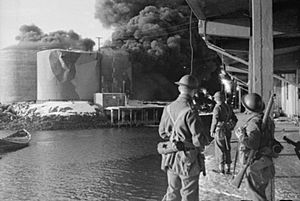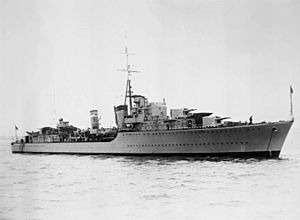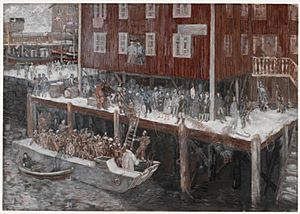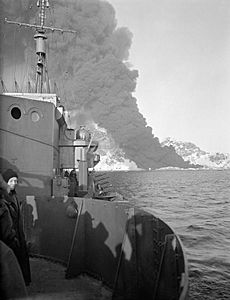Operation Claymore facts for kids
Quick facts for kids Operation Claymore |
|||||||
|---|---|---|---|---|---|---|---|
| Part of the North West Europe Campaign | |||||||
 Commandos watching fish oil tanks burning. |
|||||||
|
|||||||
| Belligerents | |||||||
|
|||||||
| Commanders and leaders | |||||||
| Unknown | |||||||
| Strength | |||||||
|
1 armed trawler | ||||||
| Casualties and losses | |||||||
| 1 wounded |
|
||||||
Operation Claymore was a secret mission during World War II. British and Norwegian soldiers, called commandos, raided the Lofoten Islands in northern Norway. This happened on March 4, 1941.
The Lofoten Islands were important because they made fish oil and glycerine. These were used by Germany to make explosives for the war. The commandos wanted to destroy these factories.
About 500 British soldiers and 52 Norwegian soldiers took part. They were supported by ships from the Royal Navy. The soldiers landed almost without anyone fighting back. They successfully destroyed the factories and a lot of oil and glycerine.
The mission also captured 228 German prisoners. They also brought back 314 Norwegians who wanted to join the fight against Germany. A very important discovery was made: parts of a German code machine called Enigma. This helped the Allies understand German secret messages.
Contents
Why Operation Claymore Happened
After British soldiers left Europe in 1940, Prime Minister Winston Churchill wanted to strike back. He asked for a special force to attack German-held areas. This would also boost British spirits.
A plan was made for "hunter class" troops to cause trouble along the enemy coast. This led to the creation of the commandos. Their first mission was a small raid that didn't do much damage.
Forming the Commandos
The commandos were led by Admiral Roger Keyes. Many soldiers volunteered for this new special force. They came from different army groups in Britain. By late 1940, over 2,000 men had joined. They were organized into 12 special units called commandos.
The Lofoten Islands raid was their first big mission. The islands were far north, inside the Arctic Circle. The plan was to land at four small ports. The goal was to destroy factories that made fish oil. This oil was sent to Germany to make glycerine, which was vital for explosives.
The commandos traveled on two special ships that could carry troops. Four destroyers and one other destroyer from the Royal Navy protected them.
The Mission Plan
Rear Admiral Louis Keppel Hamilton led the entire mission. Operation Claymore had three main goals. The Royal Navy had to safely take the soldiers to the islands and bring them back. They also had to sink or capture any German ships or Norwegian ships helping the Germans. Finally, they would use their ship guns to support the soldiers on land.
The naval ships included HMS Somali, Bedouin, Tartar, Eskimo, and Legion. The troop ships were HMS Queen Emma and HMS Princess Beatrix.
Who Landed on the Islands
The landing force included 250 men from No. 3 Commando and 250 men from No. 4 Commando. They were joined by a small team of engineers and 52 Norwegian soldiers. Captain Martin Linge led the Norwegians.
Their tasks were to destroy the oil factories in four ports: Stamsund, Henningsvær, Svolvær, and Brettesnes. They also had to capture any German soldiers. Another goal was to find supporters of the Norwegian Quisling regime (who worked with the Germans). They also tried to convince local Norwegians to join the Free Norwegian Forces in Britain.
The soldiers gathered in the Orkney Islands on February 21, 1941. They spent a week there, getting ready. They learned how to use the landing ships and small boats. They also practiced how to support each other with their own weapons. This was important because the big destroyers couldn't get very close to the shore.
Landing on Lofoten
The ships left for Norway just after midnight on March 1, 1941. They sailed north to avoid being seen by German planes and ships. They arrived at the Lofoten Islands just before 4:00 AM on March 4. The harbor lights were on, which meant the Germans didn't expect them.
The soldiers landed at 6:50 AM. The attack was mostly unopposed. A German ship called Krebs fired a few shots at HMS Somali before it was sunk. Another Norwegian ship was accidentally sunk by HMS Bedouin.
The landing forces sank ten merchant ships, totaling 18,000 tons. These ships included Hamburg, Pasajes, Felix, Eilenau, Rissen, Andø, Grotto, and Bernhard Schulte.
Destroying Factories and Capturing Secrets
The soldiers destroyed the fish oil factories in Stamsund, Henningsvær, and Svolvær. They set fire to about 800,000 gallons of fish oil and paraffin.
They captured 228 prisoners. These included German navy, army, and air force personnel, as well as merchant sailors and some civilians.
The most important outcome was finding parts of an Enigma machine and its code books. These were taken from the sinking German ship Krebs. The ship's commander threw his machine overboard, but other parts and documents were saved.
These captured items helped the code-breakers at Bletchley Park understand German naval codes. This allowed Allied convoys to avoid German submarines. By 1:00 PM, all the soldiers were back on their ships. They also brought 300 Norwegians who volunteered to join the Free Norwegian Forces.
After the Raid
After the mission, Prime Minister Winston Churchill congratulated everyone involved. Operation Claymore was the first of 12 commando raids on Norway during World War II.
Because of these raids, Germany had to send more troops to Norway. By 1944, there were 370,000 German soldiers there. This meant fewer German troops could fight elsewhere.
The commandos from No. 3 and No. 4 Commandos later became part of the 1st Special Service Brigade. They took part in the D-Day landings in June 1944.
See also
- Operation Archery
- Operation Anklet
- Crown Film Unit account of the raid at the Imperial War Museum[1]
External sources
- Tovey, Admiral Sir John C. Commander-in-Chief, Home Fleet, Despatch on raid on military and economic objectives in the Lofoten Islands (Norway) 1941 Mar.




